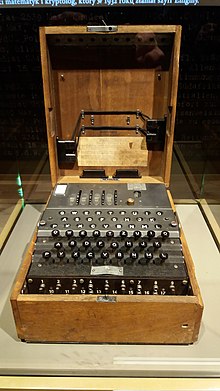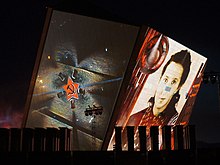Muzeum II Wojny Światowej
The Muzeum II Wojny Światowej ( Polish for “Museum of the Second World War”, abbreviated MIIWŚ) in Gdańsk (Danzig) was officially opened on March 23, 2017 after about eight years of planning and construction. After just two weeks, the independent museum was merged with the Westerplatte Museum , which was being established. The museum has been headed by historian Karol Nawrocki since April 7, 2017 - initially on a temporary basis .
controversy

In January 2017, the Muzeum II Wojny Światowej was initially temporarily opened to the interested public for several days by the founding director Paweł Machcewicz . The museum planned by Donald Tusk's government in 2008/09 is the first of its kind in post-war Poland . According to Machcewicz, the main exhibition of the museum shows the specifics of the experiences of large sections of the population in Poland during the war and fits them into the European context.
The museum concept accompanies a dispute between different authorities and those involved. The current successor government, PiS, questions this museum concept based on a comprehensive culture of remembrance . The merger of the museum with the Westerplatte Museum , which she sought in this context, was the subject of legal proceedings. On April 5, 2017, the Supreme Administrative Court upheld a lawsuit by the Ministry of Culture against the museum in the last instance. According to Minister of Culture Piotr Gliński , the two museums should be merged “as soon as possible”. The association was announced by the Ministry of Culture and National Heritage on April 6, 2017, and Nawrocki took over the management of Machcewicz, who had resigned without notice, the next day.
Paweł Machcewicz presented his book Muzeum (German: The fought war. The Museum of the Second World War in Gdansk. Origin and dispute. (2018)) in 2017 in Sopot .
The museum building
The building was designed by the architects Kwadrat in Gdynia, an international jury had decided on this design. It is an approximately 40 meter high, four-sided cube that juts out of the ground at an angle. One of the four surfaces and the top is glazed.
The concept should reflect the past, present and future: the underground exhibition areas are the past, the open spaces around the museum symbolize the present, the imposing tower with offices and a café and restaurant on the top two levels symbolize the future. The actual exhibition space of 5000 m² is located on the lowest of the underground floors. The café and restaurant were not opened until August 2019, there is a cafeteria on exhibition level -3.
location
The museum was built on a site owned by the Gdansk Transport Company. The square was named after the historian Władysław Bartoszewski , it is located on a headland between the Radaunekanal and Motława . The museum is located in the Brabank ( Stara Stocznia in correspondence and translation: old shipyard) in the city center district . A new district is being created here on industrial wastelands and the former shipyard site . The European Solidarność Center (ECS) is only 1 km away, the Polish Post Office , which was contested in 1939, only 200 m. The New Town and the residential area of Zamczysko (Castle) lie between the tourist magnet Rechtstadt and the museum .
The concept

In addition to the military resistance, the suffering of the Polish population under the German occupation of Poland up to 1945 and the temporary Russian occupation will be documented. The approximately 5 million civilians killed, of which approximately 3 million were Jews, are compared to 200,000 military victims. The Eastern European upheavals in the war years are also recalled. Parallels are drawn with the mistreatment of civilians, such as atrocities committed by the Japanese in China or ethnic cleansing in Croatia. The founding director Paweł Machcewicz said: “[W] e don't want to be a military museum, but a museum of the Second World War. We show the war from the perspective of the civilian population. "
In addition to the defense of Poland in 1939 , the exhibition also shows the resistance against the terror of the German occupiers, the Polish Home Army and its secret school system; the food situation and the destroyed apartments are discussed. Polish riots such as the Jedwabne massacre in 1941, in which Poles murdered around three hundred of their Jewish neighbors during the attacks by the Germans, are also discussed. The museum explains the various aspects of the world war , collects and presents contemporary testimonies and is intended to motivate peace in Europe.
The jury that decided on the submitted designs included the director Andrzej Wajda , the writer Stefan Chwin , the architect Daniel Libeskind and the American historian Andrew Nagorski . Not only historians (or politicians) should decide on this project. “Historians have a different view of world events,” said Tomasz Żuroch-Piechowski. "They put more emphasis on the written word." But it was important for the jury to "let the pictures speak."
Permanent exhibitions
- Open, at level -3
structure
- A: Europe between the world wars
- B: Everyday life during war and occupation
- 1: Origin and expansion of totalitarianism
- 2: peace at any price?
- 3: It's war
- 4: The Winter War
- 5: A New Kind of War
- 6: Merciless War
- 7: Occupation and collaboration
- 8: terror
- 9: Holocaust
- 10: Ethnic cleansing
- 11: Resistance
- 12: The war over secrets
- 13: Everything for victory
- 14: The Allies on the offensive
- 15: The war is over
- 16: After the end of the war
- 17: On both sides of the iron curtain
- 18: From war to freedom
- C: Children's exhibition
(As of August 2019)
Special exhibitions
- Currently none , at level -3
Archaeological exhibition
- Open, in the tower on level 0
Further exhibitions and events
The World War Museum has set up a permanent exhibition on the Westerplatte: a seaside resort, a bastion, a symbol and new display boards. Since 2011 various special exhibitions and a. in the ECS and in the Johanniskirche , museum days and events at the Westerplatte Memorial .
On August 23, 2019, the multimedia show Poland: First to Fight was staged on the anniversary of the Hitler-Stalin Pact . In addition to the projection onto the window front and the east side of the tower, it contained stage elements and was designed with spotlights and artificial smoke. Nine performances were held by August 25.
See also
- The Institute for National Remembrance (Polish Instytut Pamięci Narodowej , IPN for short) has been a state institution that has been active in this form since 1999 for archiving documents on crimes committed against Polish citizens by German and Soviet occupiers during World War II. The “ Main Commission for Research into German Crimes (from 1949: the National Socialist) crimes in Poland” ( Główna Komisja Badania Zbrodni Niemieckich or Hitlerowskich w Polsce ), founded in 1945, should be regarded as its predecessor institution . She primarily collected material for trials against Nazi war criminals.
- War museums worldwide, e.g. B. the Cabinet War Rooms or parts of the Imperial War Museum in London or the Koninklijk Museum van het Leger en de Krijgsgeschiedenis in Brussels, the National World War II Museum in New Orleans, the Central Museum of the Great Patriotic War in Moscow.
- Rada Ochrony Pamięci Walk i Męczeństwa (Council for the Preservation of Remembrance of Struggle and Martyrdom; 1947–2016; the documentation went to the IPN)
literature
- Muzeum II Wojny Światowej Catalog Wystawy Głównej (Wersja Angielska) - Museum of the Second World War - catalog of the permanent exhibition. English-language edition. 2017. ISBN 978-83-63029-65-4
- Paweł Machcewicz (translated by Peter Oliver Loew ): The fought over war. The Museum of the Second World War in Gdansk. Origin and Controversy (Polish Profiles, Volume 5). Harrassowitz, Wiesbaden 2018. ISBN 978-3-447-11035-8
- Bogusław Kopka, Paweł Kosiński: Poland First to Fight . Gdańsk 2018. (Polish) ISBN 978-83-65957-07-8
- Mia Raben: With the tank right through. In: Die Zeit 7/2017 of February 9, 2017, page 17 (description of the museum, on the dismantling of Polish Holocaust research , suspension of the ministerial decree by the regional administrative court on January 30, 2017)
- Judith Leister: A museum as a battlefield . Interview with Paweł Machcewicz, in: NZZ , June 24, 2017, p. 25.
- Daniel Logemann / Juliane Tomann: dishes instead of history? The Museum of the Second World War in Gdańsk , in: Zeithistorische Forschungen 16 (2019), pp. 106–117.
Web links
- Photos of the construction progress, on the museum website (Polish)
- Museum of the Second World War in Gdansk (Polish and English)
- Paweł Machcewicz, Piotr M. Majewski: koncepcji programowej Muzeum II Wojny światowej w Gdańsku " ( Memento of 27 November 2010 at the Internet Archive ). (PDF file with the presentation of the concept. Polish)
- Controversial World War Museum in Gdansk opens its doors (March 22, 2017)
Links to the controversy
- Video of the news editorial team at the opening (2 min)
- World War II Museum in Gdansk - The Polish Reverse Volte. In: www.deutschlandradiokultur.de from September 13, 2016 (Ulrich Herbert in conversation with Anke Schaefer)
- Stephan Stach: Every nation has its own truth. In the FAZ of May 23, 2016
- Hans Brandt: The museum of the offense. (tagesanzeiger.ch of October 13, 2016)
- Neal Ascherson: Danzig, Gdansk and the past In: www.monde-diplomatique.de, December 8, 2017: “A visit to the new museum of the Second World War that does not suit the Polish government”
References and comments
- ^ The long shadow of the war in FAZ of March 23, 2017, page 11
- ↑ a b Museum of the Second World War in Gdansk opened at orf.at, March 23, 2017 (accessed on March 23, 2017).
- ^ Paul Flückiger: Dispute over the Polish World War Museum: Victory of the Patriots - Politics in Tagesspiegel, Berlin. Accessed April 6, 2017.
- ↑ Ministry of Culture and National Heritage: Muzeum II Wojny Światowej i Muzeum Westerplatte i Wojny 1939 połączone (April 6, 2017, Polish)
- ↑ Architecture as a symbol ( Memento of the original from July 27, 2017 in the Internet Archive ) Info: The archive link was inserted automatically and has not yet been checked. Please check the original and archive link according to the instructions and then remove this notice.
- ↑ Museum founder on Poland's memory - “What did they do?” In: taz.de. March 22, 2017. Retrieved June 18, 2018 .
- ↑ Katarzyna Tuszynska: Belgians design a new World War II museum in Poland - dispute over how the Second World War is viewed. In: .ostpol.de. November 23, 2009. Retrieved June 18, 2018 .
- ↑ muzeum1939.pl: Widowisko multimedialne “Poland: First to Fight”. (Polish, accessed September 13, 2019)
Coordinates: 54 ° 21 ′ 21.6 ″ N , 18 ° 39 ′ 38.9 ″ E


